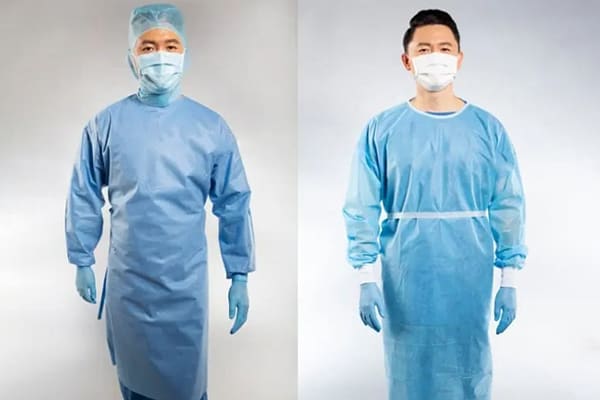In the medical field, personal protective equipment (PPE) is crucial in ensuring the safety of both healthcare workers and patients. Among the essential components of PPE are surgical gowns and isolation gowns, each designed for specific purposes. While these gowns may appear similar at first glance, they serve distinct roles in healthcare settings. Understanding the differences between surgical gowns and isolation gowns is vital for their proper use and for ensuring optimal protection.
Purpose and Application
The primary difference between surgical gowns and isolation gowns lies in their intended purpose and application.
Surgical Gowns: These are primarily used in operating rooms and during surgical procedures. The main objective of surgical gowns is to protect both the patient and the healthcare worker from the transfer of microorganisms, body fluids, and particulate matter. Surgical gowns are designed to maintain a sterile field, ensuring that the patient is not exposed to contaminants that could cause infections during invasive procedures. They are typically made from materials that are resistant to liquid penetration, providing a high level of protection.
Isolation Gowns: On the other hand, isolation gowns are used more broadly across various healthcare settings, including hospitals, clinics, and laboratories. The main function of isolation gowns is to protect healthcare workers and patients from the spread of infectious diseases, especially in environments where contact with bodily fluids is likely. Isolation gowns are essential in preventing cross-contamination between patients and healthcare providers, particularly in situations where exposure to infectious agents is a concern. These gowns are generally used during non-surgical procedures and patient care activities.
Material and Design
The materials and design of surgical gowns and isolation gowns also differ, reflecting their specific uses.
Surgical Gowns: Surgical gowns are usually made from higher-grade, fluid-resistant materials such as tightly woven cotton or synthetic fabrics like polyester or polypropylene. These materials are often treated with a special coating to enhance their barrier properties against fluids and pathogens. The design of surgical gowns focuses on providing maximum coverage while maintaining comfort and breathability for the wearer. They typically have reinforced areas around the chest and sleeves, where exposure to fluids is most likely during surgery.
Isolation Gowns: Isolation gowns, in contrast, are often made from lightweight materials such as spun-bond polypropylene or other synthetic fabrics. These materials are designed to provide an adequate barrier against fluids and contaminants, but they are generally less fluid-resistant than the materials used in surgical gowns. Isolation gowns are designed for ease of use, with ties or Velcro closures at the back, and are often intended for single use to prevent the risk of cross-contamination.
Levels of Protection
Both surgical and isolation gowns come in different levels of protection, classified by standards set by organizations such as the Association for the Advancement of Medical Instrumentation (AAMI).
Surgical Gowns: Surgical gowns are classified based on their fluid barrier performance, ranging from Level 1 to Level 4. Level 1 gowns offer the lowest level of protection and are typically used in minimal-risk environments, such as during basic care. Level 4 gowns provide the highest level of protection, suitable for high-risk situations involving long, fluid-intensive surgeries. The higher the level, the more resistant the gown is to fluid penetration.
Isolation Gowns: Isolation gowns are also categorized into levels, with Level 1 offering basic protection and Level 4 providing the highest level of protection against fluid and pathogen exposure. The choice of isolation gown level depends on the expected level of exposure to fluids and contaminants during a specific medical procedure or patient care activity.
Usage Guidelines
Understanding when to use surgical gowns versus isolation gowns is crucial for ensuring proper protection in healthcare settings.
Surgical Gowns: These gowns should be worn during all surgical procedures or in any situation where a sterile environment is required. They are essential in preventing the transfer of microorganisms from healthcare workers to the patient and vice versa, maintaining the sterility of the operating field.
Isolation Gowns: Isolation gowns should be used in situations where there is a potential for contact with infectious materials. This includes patient care activities, handling of contaminated materials, and environments where exposure to infectious agents is a concern. They are particularly important during outbreaks of infectious diseases, such as during the COVID-19 pandemic, to prevent the spread of the virus.
Conclusion
In summary, while surgical gowns and isolation gowns may look similar, their differences are significant in terms of purpose, material, design, and levels of protection. Surgical gowns are intended for use in sterile environments, providing high levels of protection during invasive procedures. Isolation gowns, on the other hand, are designed for broader use in various healthcare settings to protect against the spread of infectious diseases. By understanding these distinctions, healthcare professionals can ensure they are using the appropriate gown for the task at hand, ultimately enhancing safety and preventing the spread of infections.
Post time: 9月-09-2024






